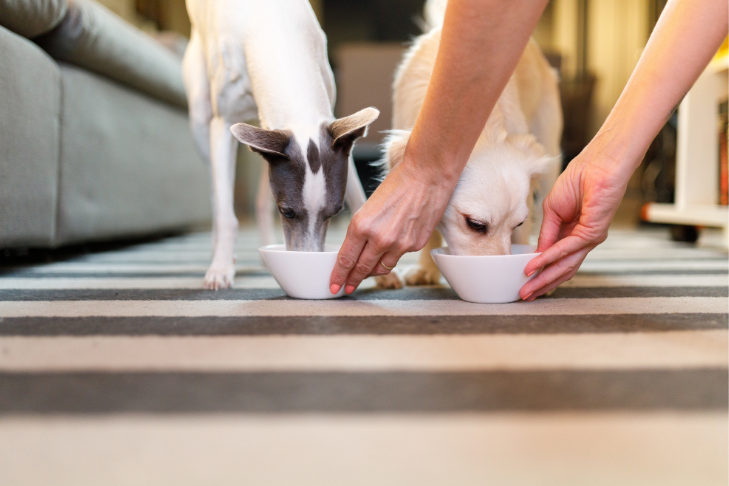How to Read Pet Food & Supplement Labels

As pet parents, we want to provide our animals with food that keeps them happy, healthy, and meets their nutritional needs. However, this is sometimes easier said than done, given the complexity of pet food labels currently on the market. Two seemingly identical pet products might have significantly different price tags, with the only obvious difference being the brands.
We understand how easy it can be to get overwhelmed. Ever found yourself staring at two bags of pet food that look the same but have a price difference that could fund your coffee habit for a week? Yeah, we’ve been there, done that. But believe it or not, those price tags might be telling you more than just how much you need to pay at the register. Despite how similar some products might seem at first glance, a quick scan of the label can show just how different the items are.
So, how do you sift through the marketing fluff and find products you can trust for your pets? We’ll give you the lowdown on how to pick a winner and cover the most common information included on pet food labels, what specific terms mean, and how to determine whether a product meets your pet’s nutritional needs.
Label Categories on Pet Food
Pet food labels, specifically on cat and dog food products, typically feature several standard categories. These categories provide crucial information about the product and its suitability for your pet’s dietary needs. Here’s what you can usually find on these labels:
- Manufacturer’s Name and Address: This information helps you identify the producer of the food, allowing for direct contact in case of inquiries or feedback.
- Nutritional Adequacy Statement: This statement confirms that the food product offers a specific blend and level of nutrients, which has been verified through testing to meet your pet’s dietary requirements.
- Brand Name: The product’s brand name distinguishes it from other offerings on the market.
- Guaranteed Analysis: This guarantee offers a breakdown of the food blend’s laboratory analysis, detailing the percentages of key components like protein, fat, fiber, and moisture.
- Feeding Instructions: These guidelines suggest appropriate serving sizes and feeding frequencies based on your pet’s size, age, and activity level.
- Quantity of Food: The amount of food in the package is listed, which may be indicated by weight, volume, or count, helping you understand how much product you’re purchasing.
- Caloric Content: This information specifies the number of calories per serving, assisting in managing your pet’s diet to prevent underfeeding or overfeeding.
Label Wording on Pet Products
Because of the careful regulations that dog and cat food manufacturers have to follow, the wording used on pet food packaging is very specific. You may notice, for example, that some pet food products have simple titles like “chicken dog food,” while others say things like “lamb-flavored dog food” or “cat food with salmon.” The words used in these titles are intentional.
Let’s break down how to read a pet food label, focusing on what the words really mean:
- 95% Rule: When a pet food product uses the name of an ingredient in the name without a qualifier, such as “Salmon Dog Food,” that ingredient must cover at least 95% of the food’s ingredients. Additionally, according to the AAFCO (the entity that regulates pet food), the ingredient also has to make up 70% of the total food product with the inclusion of the water added. The remaining 5% of the ingredients should be nutritionally valuable items, like vitamins.
- 25% Rule: When the name of a pet food product uses an ingredient with a qualifier, like “Lamb Dinner” or “Chicken Entrée,” that ingredient has to cover at least 25% of the product’s ingredients. If more than one ingredient is named in the food title, those ingredients combined need to equal at least 25% of the product. With the added water included, this ingredient has to make up at least 10% of the total product.
- Food that uses “with” in the brand name: If you see an ingredient that accompanies the modifier “with,” that specific food only needs to contain 3% of the ingredient named. So, if the food you’re looking at says “Dog Food with Duck,” you’re probably not getting very much duck meat in the food.
- Flavoring: If the name of a dog or cat food product mentions flavor, “Chicken Flavor” for example, there isn’t a specific percentage requirement, but the ingredient must at least be detectable when testing is performed.

Decoding Pet Food Ingredient Lists
Depending on the brand and type of food you’re buying, a variety of ingredients might be listed on the label. While being able to recognize and pronounce every ingredient in your pet’s food is ideal, a long or unfamiliar ingredient name isn’t necessarily a red flag.
Certain pet foods are going to contain a slightly different blend of ingredients if the product is designed to meet a specific need. For example, food designed for senior dogs will likely contain different ingredients than weight management food for overweight cats.
That said, there isn’t a specific number of ingredients your pet food should or should not contain, but in general, limited-ingredient pet food usually indicates a more high-quality product. A product without a lot of fillers or preservatives will typically have a shorter list of ingredients than a lower-quality product.
However, deciding whether the food you’re considering is beneficial to your pet’s health should rely more on product labels than the number of ingredients. Look for phrases like “complete and balanced” on the label; this indicates that the food meets the minimum nutritional requirements for your pet. Additionally, a nutritional adequacy statement and life stage indication will provide further assurance that the food is a well-rounded product and suitable for your pet’s specific needs.
Pet Treats & Supplements
Limited-ingredient pet treats and supplements are usually going to be healthier for your pets. Supplements or pet treats with short, clear ingredient lists are oftentimes going to provide your pet with safe, palatable products you won’t have to worry about. Plenty of natural pet treats contain as few as two or three active ingredients, and each one listed is easy to identify.
For example, these calming supplements for dogs have baobab, hemp extract, and chamomile listed as the active ingredients. The inactive ingredient list is also relatively short and lists items that most people will recognize, such as rice flour, honey, peanut flour, tapioca, and Vitamin E Tocopherols (to keep the CBD chews fresh).
For pet parents who have animals with specific needs, or those uncertain about narrowing down their choices, speak with your veterinarian! They will be able to recommend options that align best with your pet.


